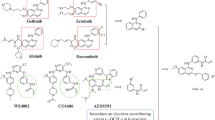Abstract
We previously reported a series of p53-elevating anthraquinone compounds with considerable cytotoxicity for acute lymphoblastic leukemia (ALL) cells. To further develop this class of compounds, we examined the effect of a few key structural features on the anticancer structure–activity relationship (SAR) in ALL cells. The active analogs showed comparable cytotoxicity and upregulation of p53 but did not induce significant downregulation of MDM2 as seen with the lead compound AQ-101, indicating the importance of the anthraquinone core scaffold for MDM2 regulation. The result from the current study not only contributes to the SAR framework of these anthraquinone derivatives but also opens up new chemical space for further optimization work.







Similar content being viewed by others
References
Anifowose A, Yuan Z, Yang X, Pan Z, Zheng Y, Zhang Z, Wang B (2020) Upregulation of p53 through induction of MDM2 degradation: amino acid prodrugs of anthraquinone analogs. Bioorg Med Chem Lett 30:126786
Bray F, Ferlay J, Soerjomataram I, Siegel RL, Torre LA, Jemal A (2018) Global cancer statistics 2018: GLOBOCAN estimates of incidence and mortality worldwide for 36 cancers in 185 countries. CA Cancer J Clin 68:394–424
Chang HY, Rodriguez V, Narboni G, Bodey GP, Luna MA, Freireich EJ (1976) Causes of death in adults with acute leukemia. Medicine 55:259–268
Draganov AB, Yang X, Anifowose A, De La Cruz LKC, Dai C, Ni N, Chen W, De Los Santos Z, Gu L, Zhou M, Wang B (2019) Upregulation of p53 through induction of MDM2 degradation: anthraquinone analogs. Bioorg Med Chem 27:3860–3865
Etzel RA (2016) Foreword: childhood leukemia and primary prevention. Curr Probl Pediatr Adolesc Health Care 46:315–316
Gaidano G, Ballerini P, Gong JZ, Inghirami G, Neri A, Newcomb EW, Magrath IT, Knowles DM, Dalla-Favera R (1991) p53 mutations in human lymphoid malignancies: association with Burkitt lymphoma and chronic lymphocytic leukemia. Proc Natl Acad Sci USA 88:5413–5417
Gu L, Zhang H, Liu T, Draganov A, Yi S, Wang B, Zhou M (2018) Inhibition of MDM2 by a rhein-derived compound AQ-101 suppresses cancer development in SCID mice. Mol Cancer Ther 17:497–507
Haupt Y, Maya R, Kazaz A, Oren M (1997) Mdm2 promotes the rapid degradation of p53. Nature 387:296–299
Hunger SP, Teachey DT, Grupp S, Aplenc R (2020) 93—Childhood leukemia. In: Niederhuber JE, Armitage JO, Kastan MB, Doroshow JH, Tepper JE (eds) Abeloff’s clinical oncology, 6th edn. Content Repository Only, Philadelphia, p 1748–1764.e1744
Hutter JJ (2010) Childhood leukemia. Pediatr Rev 31:234–241
Lozanski G, Heerema NA, Flinn IW, Smith L, Harbison J, Webb J, Moran M, Lucas M, Lin T, Hackbarth ML, Proffitt JH, Lucas D, Grever MR, Byrd JC (2004) Alemtuzumab is an effective therapy for chronic lymphocytic leukemia with p53 mutations and deletions. Blood 103:3278–3281
Malik EM, Muller CE (2016) Anthraquinones as pharmacological tools and drugs. Med Res Rev 36:705–748
Momand J, Zambetti GP, Olson DC, George D, Levine AJ (1992) The mdm-2 oncogene product forms a complex with the p53 protein and inhibits p53-mediated transactivation. Cell 69:1237–1245
Prokocimer M, Molchadsky A, Rotter V (2017) Dysfunctional diversity of p53 proteins in adult acute myeloid leukemia: projections on diagnostic workup and therapy. Blood 130:699–712
Roberts AM, Miyamoto DK, Huffman TR, Bateman LA, Ives AN, Akopian D, Heslin MJ, Contreras CM, Rape M, Skibola CF, Nomura DK (2017) Chemoproteomic screening of covalent ligands reveals UBA5 as a novel pancreatic cancer target. ACS Chem Biol 12:899–904
Slats AM, Egeler RM, van der Does-van den Berg A, Korbijn C, Hahlen K, Kamps WA, Veerman AJ, Zwaan CM (2005) Causes of death–other than progressive leukemia–in childhood acute lymphoblastic (ALL) and myeloid leukemia (AML): the Dutch Childhood Oncology Group experience. Leukemia 19:537–544
Terwilliger T, Abdul-Hay M (2017) Acute lymphoblastic leukemia: a comprehensive review and 2017 update. Blood Cancer J 7:e577
Turell L, Radi R, Alvarez B (2013) The thiol pool in human plasma: the central contribution of albumin to redox processes. Free Radic Biol Med 65:244–253
Vousden KH, Prives C (2009) Blinded by the light: the growing complexity of p53. Cell 137:413–431
Wade M, Li YC, Wahl GM (2013) MDM2, MDMX and p53 in oncogenesis and cancer therapy. Nat Rev Cancer 13:83–96
Wang L, Zhao J, Yao Y, Wang C, Zhang J, Shu X, Sun X, Li Y, Liu K, Yuan H, Ma X (2017) Covalent binding design strategy: a prospective method for discovery of potent targeted anticancer agents. Eur J Med Chem 142:493–505
Watts J, Nimer S (2018) Recent advances in the understanding and treatment of acute myeloid leukemia. F1000Res 7:1196–1209
Yang X, Sun G, Yang C, Wang B (2011) Novel rhein analogues as potential anticancer agents. ChemMedChem 6:2294–2301
Zhao Y, Wang Y, Ma S (2018) Racial differences in four leukemia subtypes: comprehensive descriptive epidemiology. Sci Rep 8:548
Zou GM (2007) Cancer stem cells in leukemia, recent advances. J Cell Physiol 213:440–444
Acknowledgements
Financial support from the National Institutes of Health (CA180519) is gratefully acknowledged. We also thank the Center for Diagnostics and Therapeutics for a University fellowship to AA, the Georgia Research Alliance for an Eminent Scholar endowment, and GSU internal support.
Author information
Authors and Affiliations
Corresponding authors
Ethics declarations
Conflict of interest
The authors declare that they have no conflict of interest.
Additional information
Dedicated to Professor Robert P. Hanzlik on the occasion of his retirement after 49 years of service on the faculty of the Department of Medicinal Chemistry, University of Kansas.
Publisher’s note Springer Nature remains neutral with regard to jurisdictional claims in published maps and institutional affiliations.
Supplementary information
Rights and permissions
About this article
Cite this article
Anifowose, A., Agbowuro, A.A., Tripathi, R. et al. Inducing apoptosis through upregulation of p53: structure–activity exploration of anthraquinone analogs. Med Chem Res 29, 1199–1210 (2020). https://doi.org/10.1007/s00044-020-02563-y
Received:
Accepted:
Published:
Issue Date:
DOI: https://doi.org/10.1007/s00044-020-02563-y




